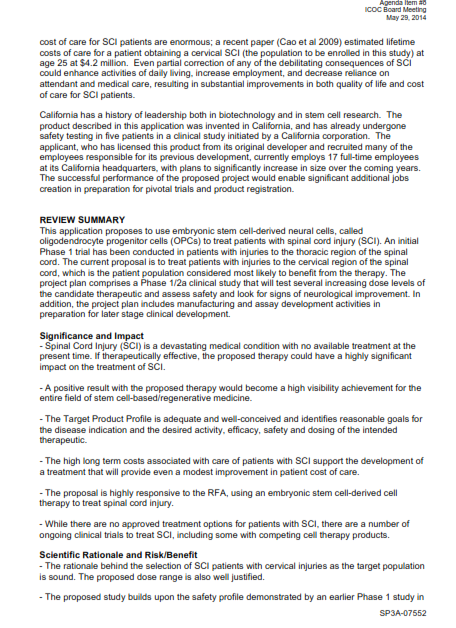Above is a CIRM video involving one of the participants in the original Geron trial.
LA JOLLA, Ca. – The state of California
today pumped $14.3 million into an historic clinical trial for a stem
cell therapy that was once abandoned because it was deemed too risky
financially by the firm that devised the treatment.
The action came when the
governing board of the California Institute for Regenerative
Medicine (CIRM) approved the award to Asterias Therapeutics of Menlo
Park, Ca., a subsidiary of BioTime, Inc., of Alameda, Ca. The firms purchased the spinal cord injury treatment along with the human
embryonic stem cell assets of Geron Corp., also of Menlo Park, in
2013.
The scientists who reviewed the
Asterias application said the therapy could have a “highly
significant impact” on the spinal cord injury,
which
afflicts more than 200,000 people nationwide. According to a
CIRM review summary, the reviewers said a successful result from the
trial would be a “high visibility achievement for the entire field
of stem cell-based/regenerative medicine.”
The Geron clinical trial was the first
ever in the United States for a therapy based on human embryonic stem
cells, an area of research roiled by controversy. Some persons
believe that deriving such cells is tantamount to killing a human
being.
Geron submitted nearly 28,000 pages of
material to the FDA in its years-long bid to start the trial, which
began in 2010. However, in November 2011, the company stunned the stem cell
world by giving up on the trial, citing business reasons.
The action also shocked the stem cell
agency, which less than four months earlier had signed an agreement
loaning the company $25 million. The agency's governing board gave
the go-ahead on the loan during a process that involved
major departures from its normal procedures. Geron repaid the loan with
interest.
Approval of the funds for Asterias was
not unexpected. The
California Stem Cell Report carried an item
on the matter May 22.
Today,
Jonathan Thomas, chairman of the CIRM board, said in a statement,
“This new investment means we have a
chance to build on the lessons we learned first time around. If this therapy can
achieve even very modest improvements for patients, it could have an
enormous impact on the quality of their life, and the lives of their
families."
CIRM's scientific grant reviewers, all
of whom are from out-of-state, gave the Asteria application a score
of 76 out of 100 during their closed-door review of the proposal.
Asterias, which currently has 17 employees including some from Geron,
said in its application,
“Initial clinical safety testing was
conducted in five subjects with neurologically complete thoracic
injuries. No safety concerns have been observed after following these
five subjects for more than two years. The current project proposes
to extend testing to subjects with neurologically complete cervical
injuries, the intended population for further clinical development,
and the population considered most likely to benefit from the
therapy.
“Initial safety testing will be
performed in three subjects at a low dose level, with subsequent
groups of five subjects at higher doses bracketing the range believed
most likely to result in functional improvements. Subjects will be
monitored both for evidence of safety issues and for signs of
neurological improvement using a variety of neurological, imaging and
laboratory assessments.”
Asterias' application continued,
“By completion of the (Phase 1/2a)
project, we expect to have accumulated sufficient safety and dosing
data to support initiation of an expanded efficacy study of a single
selected dose in the intended clinical target population.”
While reviewers praised the bulk of the
proposal they also raised concerns. They “questioned the strength
of the preclinical efficacy data.” They “expressed concern
regarding the manufacturing plan and strategy to support future
development, which they viewed as risky.” They also said the
budget “may be high.”
BioTime, which is headed by the founder
of Geron,
Michael West, is a publicly traded firm. Its stock price
closed at $2.73 yesterday. Its 52-week price range runs from $2.21 to
$4.82.
Here is a
link to the CIRM press release on the grant.




